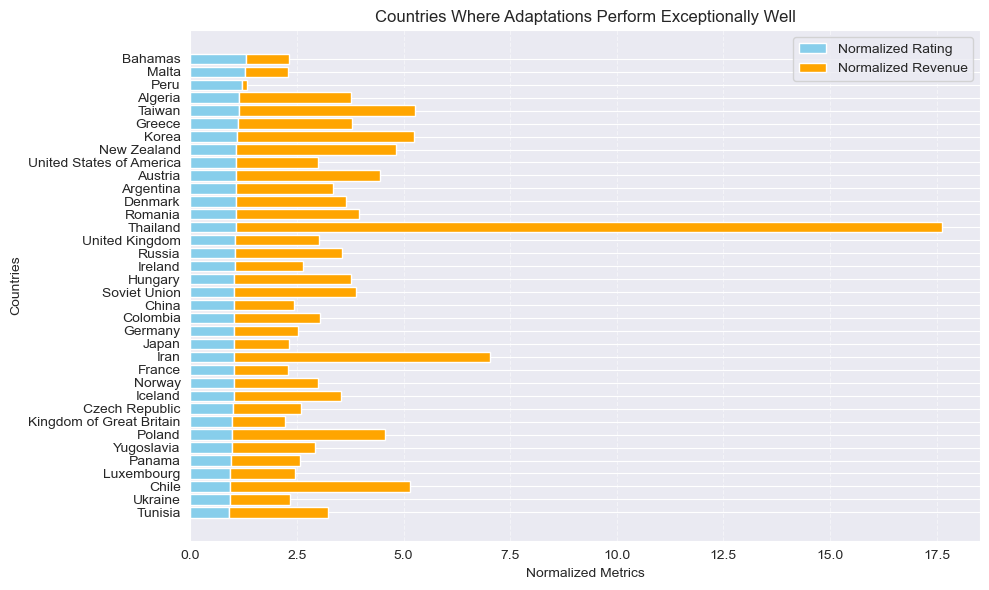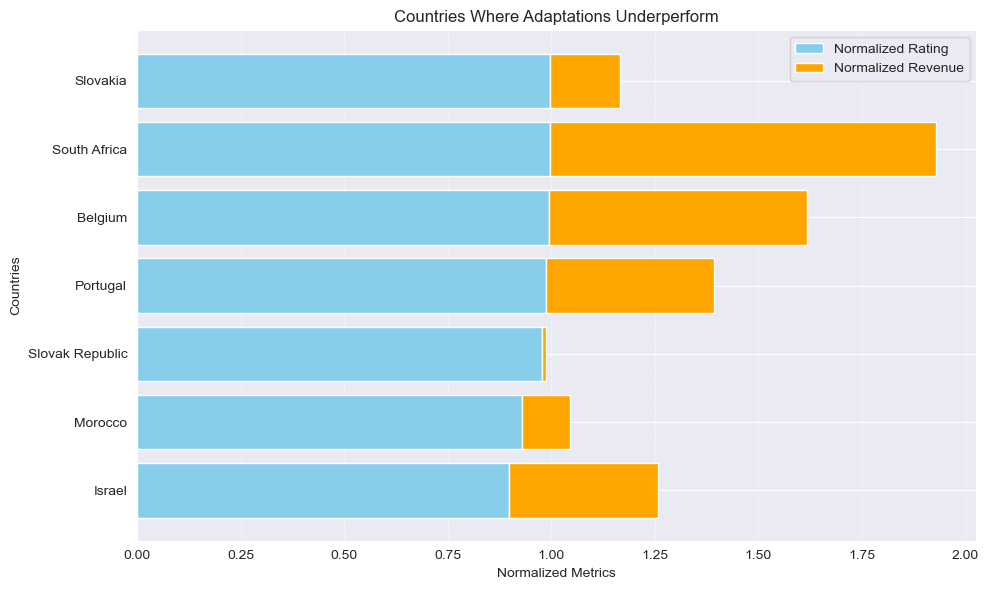The Global Reception
The Global Reception: Do Adaptations Translate Well Across Borders?
A story may begin in a writer’s study, but when it reaches the big screen, it takes on a global identity, shaped by cultural nuances, industry dynamics, and audience preferences. Adaptations offer a unique window into how storytelling transcends borders—but they also reveal the challenges of navigating the cultural and economic landscape of global cinema.
Where the Spotlight Shines Brightest
At first glance, the maps of raw adaptation revenue and ratings make one thing abundantly clear: the United States and the United Kingdom are the undisputed titans of the adaptation world.
Revenue Powerhouses
The United States and United Kingdom’s dominance is no surprise, given their established film industries, global cultural influence, and access to substantial financial resources. Hollywood, for instance, is the epicenter of blockbuster filmmaking, with budgets that dwarf those of other countries. The United Kingdom, while smaller in scale, boasts a rich literary heritage that has provided the basis for globally successful franchises like Harry Potter and The Lord of the Rings.
But why do these countries lead so decisively? Several factors stand out:
- Cultural Exportability: Stories originating from these regions often carry universal themes or archetypes that resonate across cultures.
- Distribution Networks: Their films benefit from unparalleled access to international markets, ensuring wide reach and profitability.
- Global Recognition: Both countries have positioned themselves as cultural beacons, where an adaptation carries the weight of prestige.
While these observations confirm expectations, they also raise the question: are other countries truly underperforming, or is this dominance masking hidden success elsewhere?
The Normalized View: Unearthing Hidden Gems
Raw numbers can overshadow smaller markets where adaptations punch above their weight. To adjust for this, we normalized adaptation performance by dividing each country’s average adaptation revenue and IMDb rating by the respective baseline metrics of all films in that country.
Why Normalize?
Normalization allows us to uncover hidden patterns by leveling the playing field. Countries with smaller markets or fewer high-budget productions might still achieve remarkable adaptation success relative to their local industries. It also highlights outliers—countries where adaptations perform significantly better or worse than expected, relative to their overall film industries.
Overperforming Regions

Countries like Iran, Chile, and Thailand emerge as stars in this normalized view. Their adaptations perform 4 to 17 times better than average, a stark contrast to their limited visibility on the global stage.
- Iran: Adaptations thrive on deep cultural resonance and government support for national cinema, which often prioritizes storytelling rooted in local traditions.
- Chile: The country’s adaptations excel in emotionally driven narratives, which resonate strongly with domestic audiences, creating a loyal base for niche success.
- Thailand: With its rich folklore and mythological stories, adaptations capitalize on culturally unique content that has the potential to intrigue both local and international viewers.
These countries demonstrate that success isn’t necessarily about raw revenue—it’s about how effectively adaptations connect with their intended audiences. Their overperformance also underscores the value of localized storytelling: adaptations rooted in cultural specificity are better equipped to resonate deeply.
Underperforming Regions

In stark contrast, countries like South Africa, Portugal, and Belgium show consistently underwhelming performance. Both normalized ratings and revenues fall below the baseline, raising key questions:
- South Africa: Limited production budgets and an industry still developing its global distribution channels hinder widespread success.
- Portugal and Belgium: Their struggles might stem from a mismatch between source material and audience preferences. For instance, adaptations may fail to capture cultural nuances that appeal to local viewers, diluting their impact.
This underperformance points to the importance of strategic alignment between the adapted story, the production process, and audience expectations. Without this harmony, even high-potential adaptations can falter.
Collaboration Across Borders: Strength in Numbers
While individual countries shape the reception of adaptations, the collaborative nature of filmmaking highlights another layer of complexity. A global collaboration network reveals the interconnectedness of adaptation production.
Global Collaboration Network

The centrality of countries like the United States, United Kingdom, France, and Germany emphasizes their dominance as hubs of collaboration. These countries benefit from:
- Resource Pooling: Shared expertise, technology, and financing elevate production quality.
- Cultural Capital: Partnerships between culturally influential nations amplify global appeal.
Smaller players like Australia and Canada also emerge as active collaborators, often partnering with larger hubs. Their involvement may stem from shared language and culture, which lower barriers to international collaboration.
Yet, the data also reveals a tension: while collaboration can elevate production quality, it can dilute the cultural authenticity that makes single-country adaptations resonate deeply with local audiences. This trade-off is explored further when comparing single-country and multinational productions.
Single-Country vs. Multinational Productions: A Trade-Off
Adaptations produced within a single country offer an intriguing contrast to multinational collaborations. While single-country adaptations achieve higher box office revenues, multinational productions excel in audience satisfaction, as reflected in IMDb ratings.
Revenue vs. Ratings

Key Observations:
- Single-Country Success:
- Higher box office revenues suggest a strong alignment between the adapted story and domestic audience preferences. Films like “Slumdog Millionaire” often thrive by capitalizing on local pride or familiarity.
- However, the financial success is more variable, with some films achieving exceptional returns and others faltering. This variability highlights the risks of catering exclusively to local markets.
- Multinational Strengths:
- Higher IMDb ratings point to the benefits of diverse creative input, which enhances storytelling and production quality. Films like “The Grand Budapest Hotel”, which involve international teams, offer rich, nuanced narratives that appeal to global audiences.
- Despite consistent quality, multinational collaborations face challenges in achieving blockbuster-level revenues, possibly due to fragmented audience focus.
Balancing the Data
The initial comparison revealed an imbalance in sample sizes, with single-country adaptations vastly outnumbering multinational ones. To ensure fairness, we downsampled the single-country data to match the multinational sample size.
- Post-balancing, higher revenues for single-country adaptations remained evident, reflecting their ability to align with domestic preferences.
- IMDb ratings continued to favor multinational collaborations, underscoring their consistency and global appeal.
Balancing the data refined our understanding but did not fundamentally alter the trends, affirming the validity of our initial observations.
Lessons Learned: A Complex Landscape
The global reception of adaptations is a story of contrasts and complexities. Key takeaways include:
- Established Powerhouses: The dominance of the United States and United Kingdom reflects the advantages of industry size, cultural exportability, and global networks.
- Localized Resonance: Smaller markets like Iran and Thailand demonstrate the power of cultural alignment and targeted storytelling.
- Collaboration Dynamics: Partnerships enhance production quality but may dilute cultural specificity, raising questions about balancing local authenticity with global appeal.
- Trade-Offs in Strategy: Single-country adaptations thrive on localized success, while multinational productions prioritize consistency and global relevance.
A Bridge Between Worlds
Adaptations aren’t just movies—they’re cultural bridges, bringing stories to audiences in ways that transcend borders. As the adaptation landscape evolves, understanding these dynamics becomes essential for unlocking untapped potential. In the next chapter, we’ll trace the timeline of adaptations, unraveling the journey from page to screen.